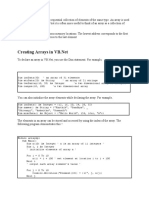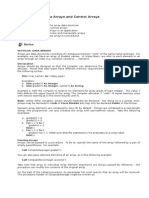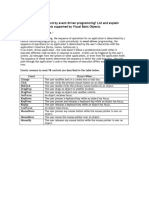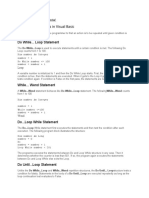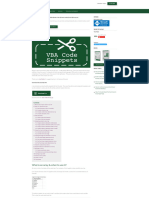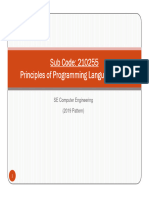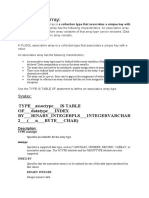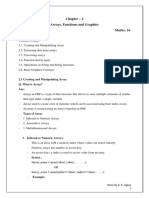How Arrays are Handled in Visual Basic (VB)
1. Introduction
In programming, an array is a data structure that can store a fixed-size sequence of elements of the same
data type.
Instead of declaring multiple variables, arrays allow us to store a collection of data under a single variable
name
and access them using an index.
Visual Basic (VB) supports arrays and provides several features for creating, accessing, and manipulating
arrays.
Arrays are particularly useful for handling large amounts of data, performing mathematical computations,
or managing collections such as student marks, names, product lists, etc.
2. Types of Arrays in VB
a) Single-Dimensional Arrays
A single-dimensional array is the most basic form of array. It stores data in a linear format (one row).
Declaration Syntax:
Dim arrayName(index) As DataType
Example:
Dim scores(4) As Integer
Assigning values:
scores(0) = 90
scores(1) = 85
scores(2) = 78
scores(3) = 92
scores(4) = 88
Accessing values:
Console.WriteLine("Score of second student: " & scores(1))
Using Loop:
For i As Integer = 0 To 4
Console.WriteLine("Student " & (i + 1) & " Score: " & scores(i))
Next
b) Multi-Dimensional Arrays
A multi-dimensional array stores data in the form of a table (rows and columns).
Declaration Syntax:
Dim arrayName(row, column) As DataType
Example:
Dim matrix(1, 2) As Integer
Assigning values:
matrix(0, 0) = 10
matrix(0, 1) = 20
matrix(0, 2) = 30
matrix(1, 0) = 40
matrix(1, 1) = 50
matrix(1, 2) = 60
Displaying the matrix:
For i As Integer = 0 To 1
For j As Integer = 0 To 2
Console.Write(matrix(i, j) & " ")
Next
Console.WriteLine()
Next
c) Dynamic Arrays
A dynamic array is declared without a fixed size and can be resized at runtime using the ReDim statement.
Declaration:
Dim arr() As String
Assigning size later:
ReDim arr(2)
arr(0) = "Apple"
arr(1) = "Banana"
arr(2) = "Mango"
Resizing with ReDim Preserve:
ReDim Preserve arr(4)
arr(3) = "Orange"
arr(4) = "Grapes"
3. Built-in Array Functions in VB
Function Description Example
UBound() Returns highest index UBound(arr) gives 4
LBound() Returns lowest index (usually 0) LBound(arr) gives 0
Length Total number of elements arr.Length
ReDim Redefines size of dynamic array ReDim arr(5)
Preserve Keeps old data on resizing ReDim Preserve arr(5)
Example:
Dim fruits() As String = {"Apple", "Banana", "Cherry"}
Console.WriteLine("Total fruits: " & fruits.Length)
Console.WriteLine("First fruit: " & fruits(LBound(fruits)))
Console.WriteLine("Last fruit: " & fruits(UBound(fruits)))
4. Practical Example: Average of Marks Using Array
Dim marks(4) As Integer
Dim total As Integer = 0
Dim avg As Double
marks(0) = 78
marks(1) = 85
marks(2) = 90
marks(3) = 82
marks(4) = 76
For i As Integer = 0 To 4
total += marks(i)
Next
avg = total / 5
Console.WriteLine("Average marks = " & avg)
5. Real-life Applications of Arrays in VB
- Storing and processing large datasets (e.g., student marks, employee salaries)
- Performing matrix operations in mathematical applications
- Managing records in memory before saving to a database
- Developing small games or simulations that need grids or levels
- Storing sensor data in real-time systems
6. Advantages of Arrays in VB
- Efficient memory use: Reduces the number of variables.
- Indexed access: Easy and fast access using index values.
- Organized storage: Helps in storing related data in sequence.
- Looping support: Can be easily manipulated using For or For Each loops.
7. Limitations of Arrays in VB
- Fixed size (for static arrays): Must define the size at the time of declaration.
- Same data type: Cannot store mixed data types.
- Complexity increases with dimension: Multi-dimensional arrays become harder to manage.
- No built-in methods for sorting/searching: Need extra code or external libraries.
8. Difference between Static and Dynamic Arrays
Feature Static Array Dynamic Array
Size Fixed Can be resized
Declaration Dim a(5) Dim a()
Resize Not allowed Allowed using ReDim
Flexibility Less More
9. Conclusion
Arrays in Visual Basic are a fundamental tool for efficient programming. They provide a structured way to
handle
multiple values of the same data type. Whether it's storing a list of names, processing numerical data,
or managing tables, arrays are essential for simplifying complex problems. Visual Basic enhances the use of
arrays
with features like dynamic resizing, looping, and built-in functions, making them powerful and flexible.














